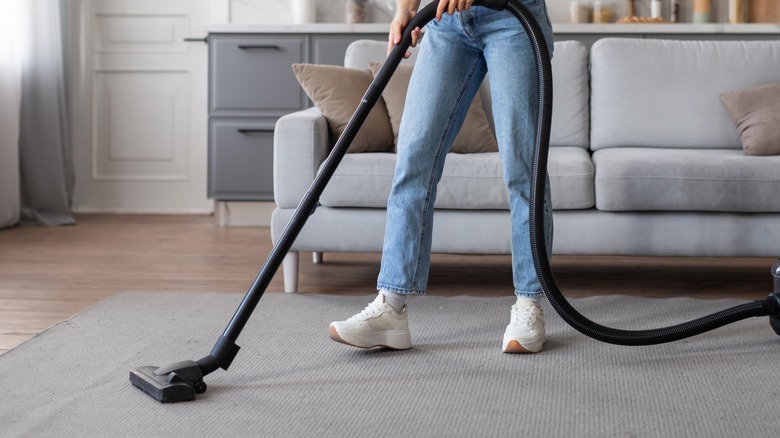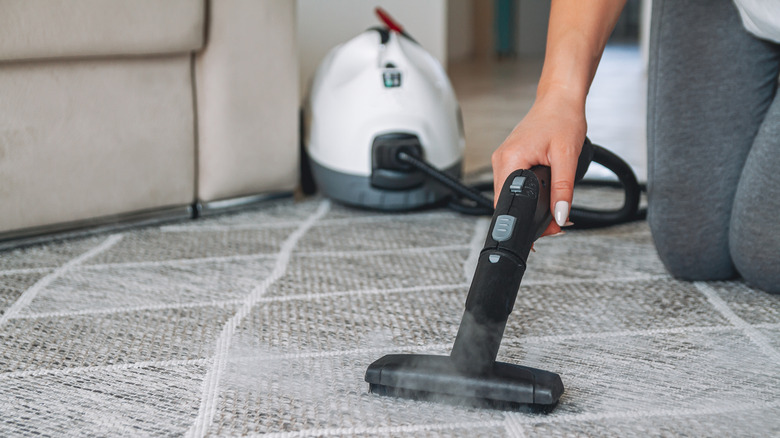Maintain Your Berber Carpet With These Effective Cleaning Tips
TikToker @donnamendoza35 wowed her #cleantok followers when she revived a client's heavily stained Berber carpet using just a mop, a few squirts of liquid soap, and some really hot water. Could the secret ingredients that will leave your dirty carpets looking brand new really be dish detergent and a common floor cleaning implement? We did some digging, and let's just say it's not a method cleaning experts generally recommend. The best methods for keeping your beautiful, bouncy, but persnickety Berber carpet in like-new shape include treating stains right when they happen, not using the brush function on your vacuum cleaner, and staying on top of maintenance. You can tackle heavyweight cleaning with a steam cleaner, but some big cleaning jobs may require a professional.
Berber carpet is renowned for its stain resistance and ability to handle even the roughest of rough-and-tumble families. The flooring boasts a distinctive and ancient tight-loop weaving style that was pioneered by the Berber people of Morocco and wider North Africa — hence the moniker. While the dense pile helps to stop spills from penetrating deep into the carpet, the loops are prone to catching and pulling. If liquids or dirt do, however, make their way into the depths of the dense carpet, they're often trapped there. It can be crafted from nylon and poly-blends — which are the easiest materials to care for — or cotton, wool, or pricey olefin. The latter is a textile notorious for capturing oil from the environment, causing the carpet to look dull over time. All of these factors combine to make Berber uniquely challenging to clean, even for flooring professionals.
Tackle stains on Berber carpet the moment they happen
A core tip is knowing how to clean common carpet stains. In the case of Berber carpet, that means dealing with spills the moment they occur. Blot at the stain with a clean, dry or damp cloth or paper towel. If the stain doesn't budge, you have a few options. White Marseille soap or mild detergent and water; a solution of 1:5 vinegar to water; baking soda paste; or store-bought carpet stain removers are all safe for Berber carpets.
Generally, professionals advise against using harsh cleaning chemicals unless, that is, you have an olefin carpet. In that case, you can tackle spots with household bleach or even sodium hypochlorite without concern — outside of personal safety recommendations, of course. Never use lots of water or you risk mold. Experts appear divided over whether you should use a brush. Some say never rub a stain, and instead encourage carpet owners to use their fingers, if anything at all. Others insist that sometimes stubborn spills demand gentle scrubbing. Use a soft-bristled brush — a soft toothbrush works well — or a sponge.
You can also vacuum up dry spills like trekked-in dirt from muddy boots or the flaxseed powder that was going to go into your smoothie that morning. The caveat here is that you should set your vacuum to suction-only, keeping those brush or beater bar attachments tucked up — or better yet removed, if that's an option — and far away from those highly snaggable loops of nylon or wool. Fuzzing and shedding are never a good look.
Regular maintenance means you won't have to steam clean your entire Berber carpet
Use the strongest suction setting and run the vacuum over the same area multiple times. If you plan to give your carpet a deeper clean with, say, a steam cleaner, vacuum thoroughly first. Pretty much anyone can operate a steam cleaner, and they don't use too much water. Berber carpet is thick and doesn't dry easily; oversaturation leads to shrinking, bad smells, or even mold. If you're renting or buying a steam cleaner, look for a one designed for use with Berber carpets specifically. A few precautions ... Test the steam cleaner in the corner of a rarely used room first to make sure it's right for your carpet, use a medium heat setting, and tackle the task on a warm day when the house is empty to encourage quick drying. Bonus: Steam cleaning tackles allergens like dust mites, too.
While Berber carpets are undeniably durable, they're also kind of high-maintenance. You need to keep on top of vacuuming to ensure dirt and grime don't get embedded deep into the thick pile. How often do you need to clean your carpet? Experts recommend you vacuum a Berber carpet a lot. We're talking at least once a week, though some carpet sellers recommend twice a week. For high-traffic areas, you might even want to increase the frequency or cover it with additional rugs or runners. If you don't already, start asking family members to take off their shoes before they come inside, and restrict spillable consumables to tiled or easy-clean areas of your home.

